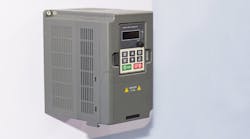Industrial facilities commonly use variable-frequency drives (VFDs) to control the speed at which alternating current motors operate. Let’s examine a couple of typical scenarios commonly encountered when designing the branch-circuit short-circuit and ground-fault protection device for a low-voltage (460V, 3-phase) motor branch circuit that includes power conversion equipment (VFD).
Scenario No. 1 Example:
A 480V, 3-phase, motor control center (MCC) has a cubicle that contains an instantaneous breaker (motor circuit protector/MCP) and VFD as protection for the motor branch circuit. The assembly is not listed as a combination motor controller or a self-protected motor controller. However, the MCP is properly sized for the drive and the motor. The VFD is marked as containing overload protection for the motor. Is the branch circuit and motor properly protected per the National Electrical Code (NEC)?
Scenario No. 1 Answer:
No, the branch circuit is not protected properly. Section 430.130(A)(4) allows an instantaneous circuit breaker to protect the branch circuit, which incidentally includes the VFD, the conductors between the MCP breaker and the drive, and also downstream of the drive to the motor. When using an MCP breaker, the equipment must be listed as a single assembly that includes all of the components including the drive as a combination motor controller.
Scenario No. 2 Example:
A 480V, 3-phase, MCC contains a cubicle in which an inverse-time (thermal magnetic) circuit breaker feeds an external VFD mounted on the wall of the same building. Due to the physical size of the VFD, it cannot be installed within the MCC. The circuit breaker is listed and sized based on the ampacity table 430.250 and Table 430.52. The MCC vertical section is listed, but the cubicle is not. The VFD is a listed piece of equipment. The VFD contains overload protection and is marked to indicate such. All equipment and conductors are sized and installed properly. Is this installation NEC compliant even though the components are not listed as a combination motor controller?
Scenario No. 2 Answer:
Yes, this installation would be Code compliant. Since an inverse-time breaker was used and sized per Table 430.52 based on the full-load currents found in Table 430.250, the VFD can be installed as a separate component outside the MCC. The breaker rating cannot be set higher than the manufacturer of the drive stipulates. In this case, the installation complies with NEC 430.130(A)(1) and (2), which, in turn, indicates NEC 430.52(C)(1) can be used. And the drive includes overload protection as required by 430.124.
Following is a summary of the requirements for sizing motor branch-circuit short-circuit and ground-fault protective devices for a low-voltage motor branch circuit that includes a VFD:
- Where utilizing VFDs, if MCP breakers are used as the motor branch-circuit short-circuit and ground-fault protective device to protect the branch circuit, then the entire assembly, including the MCP breaker, conductors, and drive, must be listed as a combination motor controller.
- If the drive is not part of listed combination controller, or a self-protected combination controller, the motor branch-circuit short-circuit and ground-fault protective device must not be an instantaneous (MCP) breaker. The motor branch-circuit short-circuit and ground-fault protective device must comply with NEC 430.130(A)(1). This would mean that a thermal breaker, nontime delay fuses, time-delay fuses, or semiconductor fuses must be used as the motor branch-circuit short-circuit and ground-fault protective device.
- According to current product standards for low-voltage VFDs, the drives are considered to be part of the motor branch circuit.
© 2019 Fluor Corporation. All Rights Reserved.



